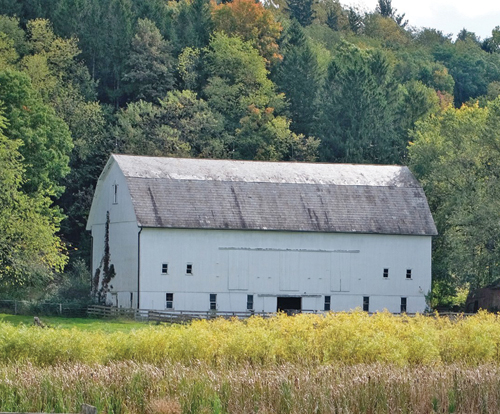Discover Bath Barns: Hale Farm & Village barns
Bath Township’s Heritage Corridors of Bath Committee manages one of 27 designated scenic byways in the state of Ohio. The Heritage Corridors of Bath byway, established in 2001, covers 39 miles of road entirely within the township and is designed to tell the story of Ohio’s Western Reserve from the Bath Township perspective: Preserve the rural heritage and maintain the bucolic landscapes for all to enjoy.
When on the byway, more than 30 barns are visible with many over 100 years old and several listed on the National Register of Historic Places. The history and heritage of these barns, like many in Ohio, are fading away.
Bath Township trustees decided to address this trend and in 2023 created a committee – Discover Bath Barns – as a means to preserve and enhance the heritage represented by these barns. This group, part of the larger Heritage Corridors of Bath Committee, has partnered with the Bath Country Journal to publish a series of articles about some of the heritage barns along the byway.
Located in the heart of Cuyahoga Valley National Park, Hale Farm & Village is an outdoor classroom featuring 32 historic structures, heritage breeds of livestock, gardens, costumed staff, early American craft and trade demonstrations and a year-round calendar of educational and public programs. The site portrays rural life through the lens of three generations of the Hale family.
The Western Reserve Historical Society was entrusted with the Hale family farm in 1956 by Clara Belle Ritchie, Jonathan Hale’s great-granddaughter, with the directive to “establish the Hale Farm as a museum, open to the public, to the end that the greatest number of persons may be informed as to the history and culture of the Western Reserve.” By 1973, Hale Farm was listed on the National Register of Historic Places as the Jonathan Hale Homestead, marking its place in history.
Hale Farm & Village has three barns built by Andrew Hale, son of Jonathan Hale: the Farm Barn, Sheep Barn and Carriage Barn. Additionally, the site features the Aten Barn and Wetmore Barn, which were relocated to Hale Farm through the “Preservation through Relocation” program, which saved pre-Civil War era structures from demolition by moving them to Hale Farm.
Hale Farm Barn
Andrew, the son of Jonathan Hale, constructed this barn in 1854 along the eastern stretch of Oak Hill Road. Notably, it stands as a testament to the period of Jonathan Hale’s life, being completed shortly before his passing in the same year. Serving as the centerpiece of the farmyard, the Farm Barn offers visitors an opportunity to engage with historical farm implements and traverse the premises, which have long housed a variety of livestock. Adjacent animal pens afford visitors the chance to observe sheep, cattle and chickens in their natural environment.
Hale Sheep Barn
Constructed by Andrew Hale in 1898 to serve as a sheep barn, this building now doubles as a space for showcasing early American craft demonstrations and educational activities. Visitors can engage in hands-on experiences such as broom making and wool spinning, offering a glimpse into historical practices.
Hale Carriage Barn
Originally utilized as a storage space for the carriages and wagons belonging to the Hale family back in 1874, this building has since evolved in purpose. Today, it serves as a shelter for museum livestock and facilitates a variety of farm chores and activities.
Aten Log Barn
The building is a large, three-bay log structure in excellent condition and is located next to the Glassworks. There is no evidence of chinking, the method used to seal log buildings, which indicates that this barn was well ventilated and exposed to extreme weather and temperatures. This barn, dating back to 1812, originated from Wellsville, Ohio. ∞

The Hale Farm Barn was built in 1854 by Andrew Hale.

The Wetmore Barn was one of two pre-
Civil War barns brought to Hale Farm.
Photo submitted.
Photo (main/above): The Carriage Barn was built in 1874 and houses museum livestock. Photos submitted.

